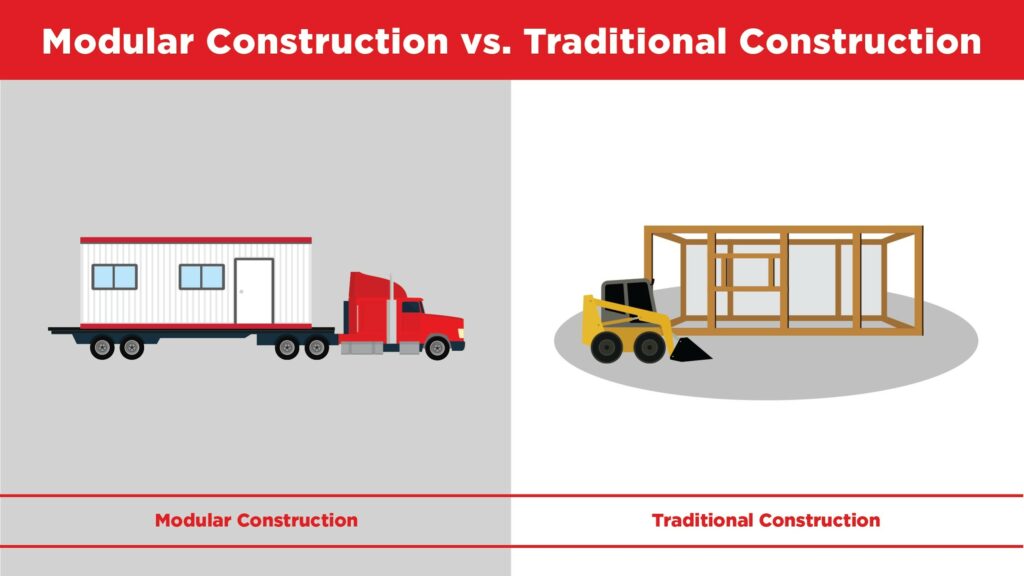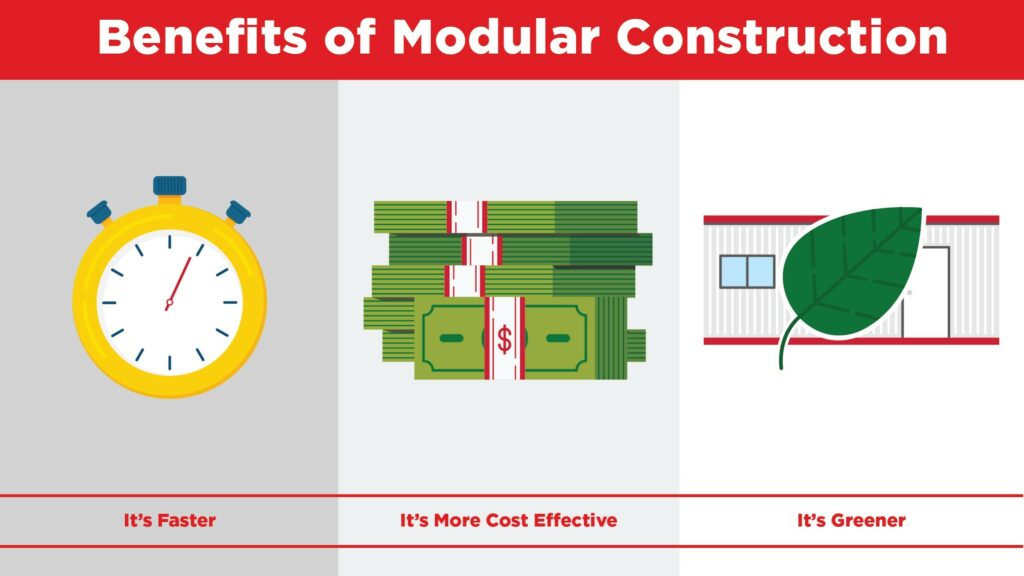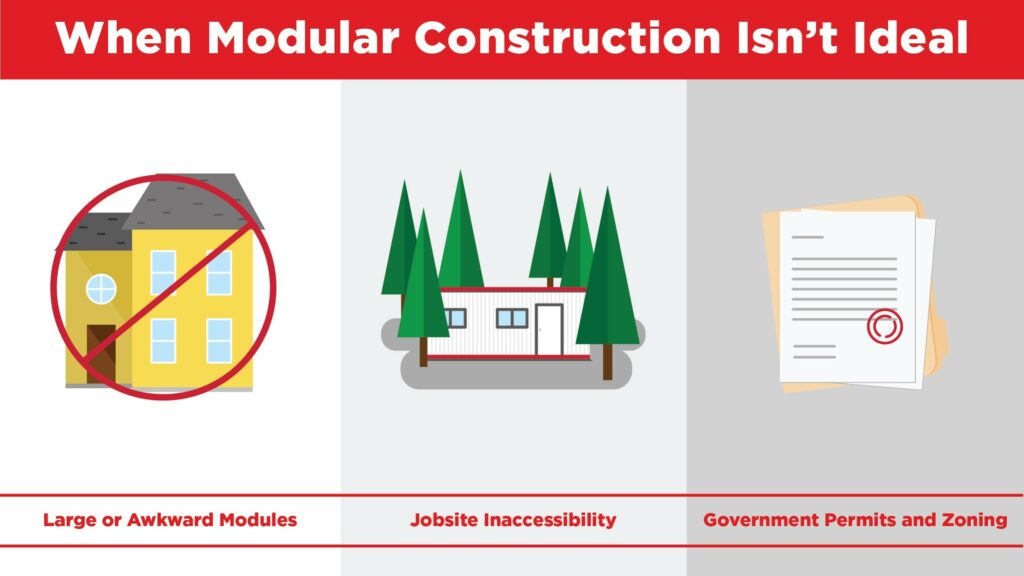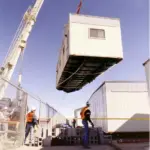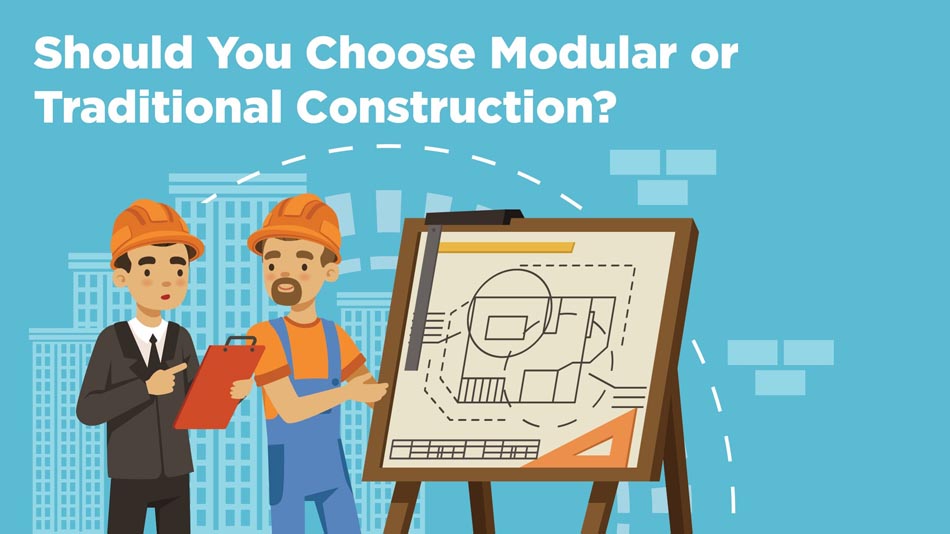
The concept of modular buildings has been around for a long time. The uses for modular construction are many, and the building technique can be employed to create hospitals, offices, schools, and more. There are a plethora of benefits that the modular construction process boasts over traditional construction, and modular construction can be a great short-term or long-term solution.
Of course, while many building projects are ideal candidates for modular construction, not every project will be a great fit. So, how should you decide? What is traditional construction versus modular construction, what are its benefits as opposed to traditional construction, and in what circumstances would modular construction not be the best fit?
What Is Modular Construction, Anyway?
Simply put, modular buildings are buildings that have been constructed in pieces in an off-site factory and assembled on site by a crew of construction workers. This is in contrast with traditional construction, where most construction work is done on site.
Not everything in traditional construction is fully built on site. Pre-hung doors and windows, along with pre-wired and pre-plumbed appliances, can be shipped to the job site for easier installation. However, modular construction takes this idea to another level of efficiency. In a traditionally constructed building, for instance, walls are framed, sheet rocked, and anchored on site. For a modular building, however, the entire structure is fully built in a factory, transported to your site, and then assembled together into one cohesive space.
There are two main types of modular buildings: permanent and temporary. Permanent modular buildings are designed to stay on site for as long as the customer needs and can be indistinguishable from traditional construction. Temporary modular buildings, on the other hand, are assembled on your site, can be disassembled at a later date, and reassembled elsewhere.
Modular construction comes in a variety of shapes and styles, including S-Plex expandable modular buildings, portable classrooms, mobile offices, and more. In addition, it’s possible to purchase, rent, or lease new and used modular buildings.
The Benefits of Modular Construction
The uniqueness of modular construction results in multiple clear advantages over traditional construction. And in some cases, modular construction is the only way to accomplish a specific construction project.
It’s Faster
Perhaps the largest individual advantage of modular construction over traditional construction is the speed at which it can be accomplished. Traditional construction requires a completely linear time period: Permits are acquired, the site and foundations are developed, and then the building is constructed.
But in modular construction, the modules themselves are built in a factory concurrently with permit acquisition and site development. While some construction obviously happens on site, the process is significantly faster—sometimes as much as 35% to 50% of time savings!
Thanks to the speed of modular construction, timelines can be met that would otherwise be considered impossible. In August 2016, intense flooding caused severe damage to the Livingston Parish School District in Baton Rouge, LA, fully destroying multiple schools. The district contracted Satellite Shelters to build three temporary, 500-student campuses complete with water lines, sewer lines, electrical lines, and other underground utilities. Thanks to modular construction, Satellite Shelters built the schools in two months.
The speed of modular construction isn’t just good for business; it also allows for projects to be completed that would be impossible otherwise.
It’s More Cost Effective
Every construction project is an investment. Modular construction allows for a faster return on investment through its ability to erect a building in significantly less time than traditional construction. Every week not spent in a new facility is money left on the table.
The modular construction process results in further savings, too, thanks to secondary factors. Factory construction means that weather delays for the project–and the accompanying cost consequences–are significantly reduced. Less time on site also leads to less potential vandalism or theft as well as a lowered potential for worker injuries.
It’s Greener
Traditional construction isn’t particularly efficient. Material waste is inevitable, and even temporary buildings constructed with traditional construction must be demolished when they are removed.
Modular construction, however, is much more efficient and a greener option than traditional construction. Less waste is generated overall, thanks to the ability for greater construction precision and inventory control in the factory, as well as fewer materials damaged or stolen on site. In addition, many modular buildings can be disassembled for reuse elsewhere, allowing for multiple uses in each module’s lifespan. Finally, because most construction is completed in a dry factory, modular construction avoids potential indoor air quality issues that stem from moisture soaking into framing materials.
When Is Modular Construction Not the Best Choice?
No two construction projects are exactly the same, and it’s important to choose the best construction method for yours. As a result, there are times when traditional construction might be a better choice for your project.
Large or Awkward Components That Cannot Be Easily Transported
Because modular buildings are constructed in a factory and assembled elsewhere, the modules themselves must be transported from the factory to the job site. In many cases, this is not a problem, as adequate highway and road access is available for most construction projects.
However, depending on the project location, or the parts themselves, it may be difficult or impossible to transport the necessary modules, especially if the site is inaccessible.
Job Site Inaccessibility for Equipment
In order to install a modular building, heavy equipment needs the space (and permits) to operate. As a result, some construction sites near heavily treed areas or tightly arranged commercial areas may not be feasible for modular construction even when a modular building may be an ideal choice. Always check with your modular building supplier early on in your project design phase to determine if modular construction will be the best option.
Government Permits and Zoning
In many cities, modular construction is just another form of construction. However, some towns may not be familiar with the specific rewards and challenges of modular construction, and, as a result, local permit and zoning laws may not be conducive to modular construction. However, a can-do attitude and a willingness to work with officials can easily overcome this obstacle if it arises.
Choose Satellite Shelters as Your Modular Construction Partner
Satellite Shelters is The First in Space. We’ve got the experience you need to make your next construction project a rewarding experience. Our products include:
- Modular buildings
- Mobile office trailers
- Portable classrooms
- Modular building design
- Specialty products and services
- And more
We have local experts with experience designing and constructing high-quality modular buildings for our customers and we would be delighted to help make your construction dream into a reality. Contact us today to request a quote, see what inventory we have in stock, and talk with us to decide if modular construction could be right for you.
